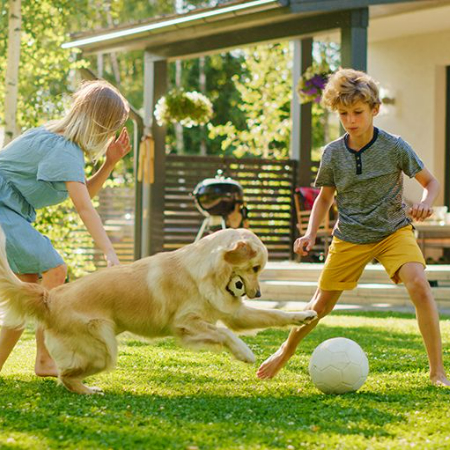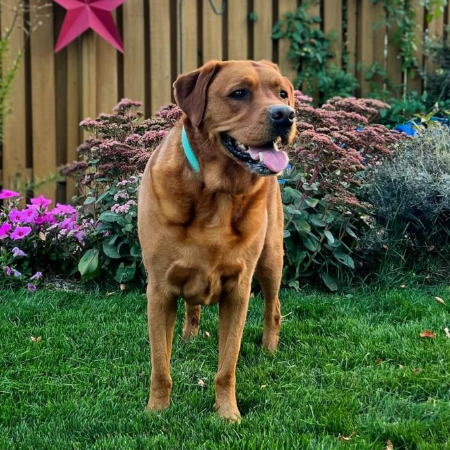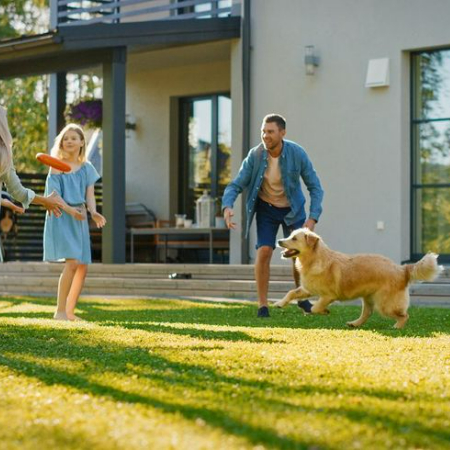How to Create a Dog-Friendly Backyard: Safety, Fun, and Enrichment Ideas.
Creating a secure, enjoyable, and stimulating environment for your dog is important, as any dog owner will relate to. It’s possible to transform your dog’s backyard from a boring plot of grass into a joyful, exploratory, and enriching paradise. Creating a backyard that is dog-friendly may keep your dog happy and healthy, regardless of whether they prefer to run, dig, or lounge in the sun.
With an emphasis on enjoyment, safety, and enrichment, here’s how to turn your backyard into your dog’s dream vacation.
1. Safety First: Secure the Perimeter
Make sure your backyard is safe before getting started on the enjoyable activities. To allow your pet to roam freely without getting lost or running into danger, you must install a dog-proof fence. To ensure that your backyard is safe, follow these tips:

Check the fence height: In order to keep your jumper safe, make sure the fence is raised high enough. Most breeds should reach a minimum height of six feet.
Inspect for gaps and holes: Look for any holes or gaps: Any tiny gaps beneath the fence or in it could provide an opening for escape. Especially if your dog enjoys digging, make sure you routinely inspect for gaps.
Use fence materials that are safe for pets: Steer clear of materials with sharp edges or ones that could hurt your dog if they go too close. Generally, safe options are wood, vinyl, or chain link.
Give additional fencing or a dog-safe hedge some thought if your dog is an especially daring animal. Their defenses against external dangers will be strengthened by this.
2. Shade and Shelter: A Cool Place to Relax
Dogs want a cool area to hide from the sun, even though they enjoy being outside. Dogs may be at risk from heat, particularly during the summer. Here are some tips for maintaining your dog’s comfort in your yard:
Add a shaded area: Create a covered space for your dog to relax in plant trees, erect a gazebo, or buy a reliable shade structure.
Dog home or protected nook: Providing your dog with a private area to retire to when they need a break from the weather can be achieved with a tiny dog house or an outdoor kennel. Just make sure that the interior is clean, well-ventilated, and not very hot.
In the summer, when it gets hot outside, think about setting up a fan or a kiddie pool under cover. Certain canines enjoy frolicking in a little swimming area to relieve heat!
3. Water Stations: Stay Hydrated
Especially while they’re racing around the backyard, dogs tend to become dehydrated. It will keep kids hydrated as they play if there is a conveniently available water station.
Automatic waterers: Dogs can always have access to clean water thanks to these convenient automatic waterers. Some of them even attach straight to your garden hose so they can refill themselves as needed.
Outdoor dog fountain: Dogs that enjoy playing or drinking from a running water source can find an outdoor dog fountain. Dogs may get some enjoyment as well as exercise from the interactive dog water fountains that turn on when your dog walks on a pedal!
A water bowl should be kept in a shaded area and frequently refilled if you’d rather go with a more traditional approach. To maintain the coolness of the water, keep it clean and out of direct sunlight.
4. Fun with Fences: Doggy Windows and Safe Views
Canines have an innate curiosity for their surroundings. You can provide your dog with a secure means of looking outside the backyard without risking an escape by installing a “doggy window” in your fence.
Fence portholes or windows: Small transparent domes known as fence portholes or windows can be affixed to a fence at dog height. With their head inserted into the bubble, your dog can observe what’s going on outside.
Lattice or mesh fencing: If your fence is made of solid material, you can add a panel of mesh or lattice that lets your dog see outside without sacrificing security.

A dog’s curiosity can be fulfilled and their chances of digging or trying to flee from boredom decreased with this kind of activity.
5. Safe Plants and Toxic-Free Landscaping
Canines shouldn’t eat every plant. It’s critical to select dog-safe plants while landscaping because several common garden plants can be harmful if consumed.
Dog-friendly plants: Select non-toxic plants such as ferns, marigolds, and sunflowers when choosing plants that are pleasant to dogs. For inquisitive dogs, these plants are safe and attractive.
Avoid toxic plants: Steer clear of harmful plants. Plants like azaleas, lilies, daffodils, and oleander should be avoided. If your dog chews on these, it may result in major health complications.
Pet-safe mulch: Dogs cannot handle the delightful scent of cocoa mulch, which is safe for pets. Choose safer options instead, such as rubber, cedar, or pine mulch.
Consider designating a specific area for your dog to dig if they enjoy digging. Toys can be buried for children to find in a small sandbox that has been filled with dirt or sand. They can indulge their digging habit without damaging your flower beds by doing this!
6. Create a Dog Playground: Fun Features and Activities
A few enjoyable things that will keep your dog engaged and mentally stimulated will help make your backyard genuinely dog-friendly.
Agility course: Jumps, tunnels, and weave poles can be used to create a basic agility course. You can use PVC pipes and other materials to make your own or purchase pre-made setups. Your dog will gain confidence and your relationship will be strengthened in addition to being a terrific way to exercise them.
Tug ropes and hanging toys: Toys that dangle and tug wheels: For tug-of-war activities, dangle a strong rope from a tree or pole. For hours on end, certain dogs can be entertained by interactive toys that hang just above their heads.
Treat receptacles and puzzle toys: Let your dog explore your yard by hiding toys or goodies. Staked-into-the-ground puzzle toys also encourage your dog to solve problems in order to receive a reward.
7. Sensory Garden: Enrich Your Dog’s Senses
Dogs use their senses to explore the world, particularly their sense of smell. A sensory garden is an area designed to pique their interest with a variety of smells, textures, and items.
Herb garden: Grow fragrant herbs like lavender, thyme, and basil. Dogs can safely sniff and investigate these, and they will like the variety of scents.
Areas of texture: Make spaces with a variety of surfaces, such as gravel, sand, grass, and smooth stones. Dogs like feeling around under their paws and discovering different surfaces.
Water elements with wind chimes: You and your dog can enjoy a soothing and enriching environment together with the soft sound of wind chimes or a gushing water fountain.
8. Lighting for Night-Time Play
As the sun sets, don’t let the good times finish! You may let your dog play outside safely at night by adding lighting to your backyard.
Motion-sensor lights: When your dog moves, these lights turn on to make sure they don’t get left out in the dark for a play session or overnight bathroom break.

Solar lights: Not only can solar lights illuminate places where your dog spends most of his time, but they are also an eco-friendly and simple-to-install lighting option.
Even at night, your dog will feel comfortable and safe in the backyard thanks to this small but thoughtful feature.
9. Regular Maintenance and Dog-Proofing
Once your backyard is dog-friendly, it’s critical to provide frequent upkeep. Check the yard for any possible dangers.
Fill-in holes: If your dog enjoys digging, plug in any new holes that they may dig. Trips and escapes are avoided in this way.
Check for broken toys or structures: Look for any damaged playthings or buildings: Make sure that any agility equipment, tunnels, or toys are still safe to use and in good working order.
Pest control: Use insect repellents and pest control techniques that are safe for pets. Always read the labels before using any traditional insecticides around dogs since some can be toxic.
Conclusion
It isn’t difficult to design a backyard that is dog-friendly. Designing an outside area where your dog feels safe, occupied, and content can be accomplished by emphasizing safety, enjoyment, and enrichment. Your dog may find adventure, relaxation, and tonnes of tail-wagging joy in your backyard with only a few easy tweaks!
Doglime for more dog-related information.
Tags










